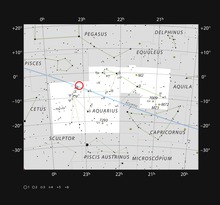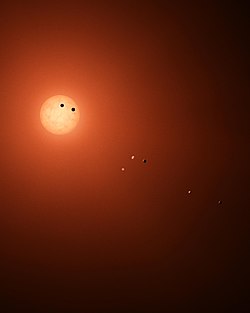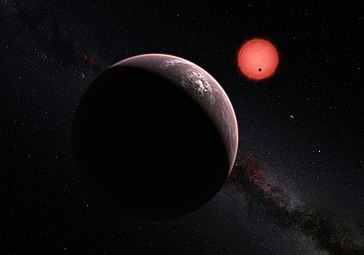User:Dadofme/sandbox
This article may be affected by a current event. Information in this article may change rapidly as the event progresses. Initial news reports may be unreliable. The last updates to this article may not reflect the most current information. (February 2017) |
| Observation data Epoch Equinox | |
|---|---|
| Constellation | Aquarius |
| Right ascension | 23h 06m 29.283s[2] |
| Declination | –05° 02′ 28.59″[2] |
| Apparent magnitude (V) | 18.80 |
| Characteristics | |
| Spectral type | M8V[3] M8.2V[note 1] |
| V−R color index | 2.33 |
| R−I color index | 2.47 |
| Astrometry | |
| Radial velocity (Rv) | −56.3 km/s |
| Parallax (π) | 82.58 mas |
| Distance | 39.5 ± 1.3 ly (12.1 ± 0.4 pc) |
| Absolute magnitude (MV) | 18.4 ± 0.1 |
| Details | |
| Mass | 0.08 ± 0.009 M☉ |
| Mass | 83.8048 ± 9.428 MJup |
| Radius | 0.114 ± 0.006 R☉ |
| Luminosity (bolometric) | 0.000525±0.000036[4] L☉ |
| Luminosity (visual, LV) | 0.00000373[note 2] L☉ |
| Surface gravity (log g) | ~ 5.227[note 3][5] cgs |
| Temperature | 2550 ± 55 K |
| Metallicity | 0.04 ± 0.08 |
| Rotation | 1.40 ± 0.05 days |
| Rotational velocity (v sin i) | 6 ± 2 km/s |
| Age | > 1 Gyr |
| Other designations | |
2MASS J23062928-0502285, 2MASSI J2306292-050227, 2MASSW J2306292-050227, 2MUDC 12171 | |
| Database references | |
| SIMBAD | data |
TRAPPIST-1, also known as 2MASS J23062928-0502285,[6] is an ultra-cool dwarf star[4][7] located 39.5 light-years (12.1 parsecs) away from Earth in the constellation Aquarius.[8]
In 2015, astronomers discovered three Earth-sized planets orbiting the dwarf star. The team, led by Michaël Gillon at the University of Liège in Belgium, detected the planets using transit photometry with the Transiting Planets and Planetesimals Small Telescope (TRAPPIST) at the La Silla Observatory in Chile.[9][7][10] On 22 February 2017, astronomers announced four additional exoplanets around TRAPPIST-1.[11] Besides TRAPPIST, this work utilized the Very Large Telescope at Paranal and the NASA Spitzer Space Telescope, among others, and brought the total number of planets orbiting the star to seven, of which at least three, and possibly all, are in its habitable zone.[12][13]
Discovery and nomenclature[edit]
The star at the centre of the system now known as TRAPPIST-1 was first catalogued in the late 1990s during the 2MASS astronomical survey. At that time it was known as "2MASS J23062928-0502285".
The system was later studied by a team at the University of Liège, who made their initial observations using the Transiting Planets and Planetesimals Small Telescope–South (TRAPPIST) from September to December 2015 and published their findings in the May 2016 issue of the journal Nature.[9][4] The star's current name, TRAPPIST-1, pays homage to the telescope, which itself acknowledges the Catholic Christian religious order of Trappists and to the Trappist beer it produces, primarily in Belgium.[14]
The planets are designated in the order of their discovery, beginning with b for the first planet discovered, c for the second and so on.[15] Three planets around TRAPPIST-1 were first discovered and designated b, c and d in order of increasing orbital periods,[4] and the second batch of discoveries was similarly designated e to h.
Stellar characteristics[edit]
TRAPPIST-1 is an ultracool dwarf star, of spectral class M8.0 ± 0.5, that is approximately 8% the mass of and 11% the radius of the Sun. It has a temperature of 2550 K and is at least 500 million years old.[4] In comparison, the Sun is about 4.6 billion years old[16] and has a temperature of 5778 K.[17]
Owing to its low luminosity, the star has the ability to live for up to 4–5 trillion years, meaning that TRAPPIST-1 should remain a main sequence star when the Universe is much older than it is now, when the gas needed to make stars will have been used up.[18] The star is metal-rich, with a metallicity ([Fe/H]) of 0.04, or 109% the solar amount. Its luminosity is 0.05% of that of the Sun (L☉), most of which is emitted in the infrared spectrum.
Planetary system[edit]
In February 2017, astronomers announced that the planetary system of this star is composed of seven Earth-like planets, three of which (e, f, g) orbit in the habitable zone.[19][20][21]

| Companion (in order from star) |
Mass | Semimajor axis (AU) |
Orbital period (days) |
Eccentricity | Inclination | Radius |
|---|---|---|---|---|---|---|
| b | 0.85±0.72 M🜨 | 0.01111 | 1.51087081 ± 0.00000060 | < 0.081 | 89.65 ± 0.25° | 1.086 ± 0.035 R🜨 |
| c | 1.38±0.61 M🜨 | 0.01522 | 2.4218233 ± 0.0000017 | < 0.083 | 89.67 ± 0.17° | 1.056 ± 0.035 R🜨 |
| d | 0.41±0.27 M🜨 | 0.021 ± 0.006 | 4.049610 ± 0.000063 | < 0.070 | 89.75 ± 0.16° | 0.772 ± 0.030 R🜨 |
| e | 0.62±0.58 M🜨 | 0.028 | 6.099615 ± 0.000011 | < 0.085 | 89.86 ± 0.11° | 0.918 ± 0.039 R🜨 |
| f | 0.68±0.18 M🜨 | 0.037 | 9.206690 ± 0.000015 | < 0.063 | 89.680 ± 0.034° | 1.045 ± 0.038 R🜨 |
| g | 1.34±0.88 M🜨 | 0.045 | 12.35294 ± 0.00012 | < 0.061 | 89.710 ± 0.025° | 1.127 ± 0.041 R🜨 |
| h | unknown (likely <1) M🜨 | 0.063+0.027 −0.013 |
20+15 −6 |
unknown | 89.80 ± 0.07° | 0.755 ± 0.034 R🜨 |

All seven of TRAPPIST-1's planets orbit much closer than Mercury orbits the Sun. The distance between the orbits of TRAPPIST-1b and TRAPPIST 1c is only 1.6 times the distance between the Earth and the moon. The planets should appear prominently in each other's skies, and in some cases, appearing several times larger than the moon appears from Earth.[23][24][failed verification] A year on the closest planet passes in only 1.5 Earth days, while the sixth planet's year passes in only 12.3 days. The seventh planet's year is much less certain at 20+15
−6 days, because only a single transit has been observed. It is probable that the rotation of each of these planets around its axis is synchronized with its translation around the star (one day = one year). Tidally locked planets likely have very large differences in temperature between their permanently lit day sides and their permanently dark night sides, which could produce very strong winds circling the planets. The best places for life may be close to the mild twilight regions between the two sides. Another important consideration is that red dwarf stars are subject to frequent, intense flares that are likely to have stripped away the atmospheres of any planets in such close orbits.[25]
The orbits of planets b-g are nearly in resonance, having relative periods of approximately 24/24, 24/15, 24/9, 24/6, 24/4 and 24/3, respectively, or nearest-neighbor period ratios (proceeding outward) of about 8/5, 5/3, 3/2, 3/2 and 4/3 (1.603, 1.672, 1.506, 1.509 and 1.342). This represents the longest known chain of near-resonant exoplanets, and is thought to have resulted from interactions between the planets as they migrated inward within the residual protoplanetary disk after forming at greater initial distances.[22] Due to the poorly-known orbital period of h, it is unknown if it is in an orbital resonance with the other six planets, although it is probably in a 2:24 resonance with the other planets.
Strong extreme-ultraviolet irradiation of the planetary system[edit]
An XMM-Newton X-ray study shows that the Earth-sized planets in the habitable zone of the star are subject to sufficient X-ray and extreme ultraviolet (EUV/XUV) irradiation to significantly alter their primary and perhaps secondary atmospheres.[26]
Spectrum of TRAPPIST-1 b and c[edit]
The combined transmission spectrum of TRAPPIST-1 b and c rules out a cloud-free hydrogen-dominated atmosphere for each planet, so they are unlikely to harbor an extended gas envelope. Other atmospheres, from a cloud-free water vapor atmosphere to a Venus-like atmosphere, remain consistent with the featureless spectrum.[27]
Tidal locking[edit]
All seven planets are likely to be tidally synchronized (or possibly but less likely trapped in a higher-order spin-orbit resonance),[22] making the development of life there "much more challenging".[28]
In popular culture[edit]
On 23 February 2017, the discovery was celebrated with an animated Google Doodle made by Nate Swinehart.[29]
Gallery[edit]
-
Artist’s impression of the TRAPPIST-1 planetary system[30]
-
Artist's view of planets transiting red dwarf star in TRAPPIST-1 system[31]
-
The Sun and TRAPPIST-1 to scale. The faint star is only 11% of the diameter of the Sun and is much redder in colour.
-
Artist's impression of a view of three planets orbiting TRAPPIST-1
-
Artist's impression of a view from TRAPPIST-1c
-
This artist’s impression video shows an imagined view from close to one of the three planets orbiting TRAPPIST-1.
-
NASA-JPL/Caltech artist's concept of what the TRAPPIST-1 planetary system may look like
-
Comparison to our solar system; all seven planets of TRAPPIST-1 could fit inside the orbit of Mercury.
-
This video takes the viewer on a quick trip from Earth, past the Moon and on to TRAPPIST-1.
See also[edit]
- Active SETI, while interstellar travel to the star's solar system is currently impossible, communication with potential extraterrestrials living on one of its planets within a human's lifespan could, hypothetically, be possible
Notes[edit]
- ^ based on photometric spectral type estimation
- ^ Taking the absolute visual magnitude of TRAPPIST-1 and the absolute visual magnitude of the Sun , the visual luminosity can be calculated by
- ^ The surface gravity is calculated directly from Newton's law of universal gravitation, which gives the formula where M is the mass of the object, r is its radius, and G is the gravitational constant.
References[edit]
- ^ "TRAPPIST-1b". Open Exoplanet Catalogue. Retrieved 2 May 2016.
- ^ a b Cutri, R. M.; Skrutskie, M. F.; Van Dyk, S.; Beichman, C. A.; Carpenter, J. M.; Chester, T.; Cambresy, L.; Evans, T.; Fowler, J.; Gizis, J.; Howard, E.; Huchra, J.; Jarrett, T.; Kopan, E. L.; Kirkpatrick, J. D.; Light, R. M.; Marsh, K. A.; McCallon, H.; Schneider, S.; Stiening, R.; Sykes, M.; Weinberg, M.; Wheaton, W. A.; Wheelock, S.; Zacarias, N. (June 2003). "2MASS All Sky Catalog of point sources". VizieR Online Data Catalog. 2246. European Southern Observatory with data provided by the SAO/NASA Astrophysics Data System. Bibcode:2003yCat.2246....0C.
- ^ Costa, E.; Mendez, R.A.; Jao, W.-C.; Henry, T.J.; Subasavage, J.P.; Ianna, P.A. (4 August 2006). "The Solar Neighborhood. XVI. Parallaxes from CTIOPI: Final Results from the 1.5 m Telescope Program". The Astronomical Journal. 132 (3). The American Astronomical Society: 1234. Bibcode:2006AJ....132.1234C. doi:10.1086/505706.
- ^ a b c d e f Gillon, M.; Jehin, E.; Lederer, S. M.; Delrez, L.; De Wit, J.; Burdanov, A.; Van Grootel, V.; Burgasser, A. J.; Triaud, A. H. M. J.; Opitom, C.; Demory, B.-O.; Sahu, D. K.; Bardalez Gagliuffi, D.; Magain, P.; Queloz, D. (2016). "Temperate Earth-sized planets transiting a nearby ultracool dwarf star" (PDF). Nature. 533 (7602): 221–224. Bibcode:2016Natur.533..221G. doi:10.1038/nature17448.
- ^ Viti, Serena; Jones, Hugh R. A. (November 1999). "Gravity dependence at the bottom of the main sequence". Astronomy and Astrophysics. 351: 1028–1035. Bibcode:1999A&A...351.1028V. Retrieved 6 May 2016.
- ^ *"2MASS J23062928-0502285". SIMBAD. Centre de données astronomiques de Strasbourg.
- ^ a b "Three Potentially Habitable Worlds Found Around Nearby Ultracool Dwarf Star – Currently the best place to search for life beyond the Solar System". European Southern Observatory.
- ^ Chang, Kenneth (22 February 2017). "7 Earth-Size Planets Identified in Orbit Around a Dwarf Star". New York Times. Retrieved 22 February 2017.
- ^ a b "Could these newly-discovered planets orbiting an ultracool dwarf host life?". The Guardian. 2 May 2016.
- ^ "Three New Planets Are the Best Bets for Life". Popular Mechanics. 2 May 2016. Retrieved 2 May 2016.
- ^ TRAPPIST-1 System – Discovery of Earth-Like Planets – Check123, Video Encyclopedia, retrieved 23 February 2017
- ^ "Temperate Earth-Sized Planets Found in Extraordinarily Rich Planetary System TRAPPIST-1". SpaceRef. 22 February 2017. Retrieved 11 February 2017.
- ^ "NASA telescope reveals largest batch of Earth-size, habitable-zone planets around single star". Exoplanet Exploration: Planets Beyond our Solar System. NASA. Retrieved 22 February 2017.
- ^ Gramer, Robbie (22 February 2017). "News So Foreign It's Out of This World: Scientists Discover Seven New Potentially Habitable Planets". Foreign Policy.
- ^ Hessman, F. V.; Dhillon, V. S.; Winget, D. E.; Schreiber, M. R.; Horne, K.; Marsh, T. R.; Guenther, E.; Schwope, A.; Heber, U. (2010). "On the naming convention used for multiple star systems and extrasolar planets". arXiv:1012.0707 [astro-ph.SR].
- ^ Williams, Matt (24 September 2016). "What is the Life Cycle Of The Sun?". Universe Today. Retrieved 19 February 2011.
- ^ Cain, Fraser (23 December 2015). "Temperature of the Sun". Universe Today. Retrieved 19 February 2011.
- ^ Adams, Fred C.; Laughlin, Gregory; Graves, Genevieve J. M. "Red Dwarfs and the End of the Main Sequence". Gravitational Collapse: From Massive Stars to Planets. Revista Mexicana de Astronomía y Astrofísica. pp. 46–49. Bibcode:2004RMxAC..22...46A.
{{cite conference}}: Unknown parameter|booktitle=ignored (|book-title=suggested) (help) - ^ "NASA Telescope Reveals Largest Batch of Earth-Size, Habitable-Zone Planets Around Single Star" (Press release). NASA.
- ^ "TRAPPIST-1 Planet Lineup". jpl.nasa.gov.
- ^ Wall, Mike (22 February 2017). "Major Discovery! 7 Earth-Size Alien Planets Circle Nearby Star". space.com.
- ^ a b c Gillon, M.; Triaud, A. H. M. J.; Demory, B.-O.; Jehin, E.; Agol, E.; Deck, K. M.; Lederer, S. M.; De Wit, J.; Burdanov, A.; Ingalls, J. G.; Bolmont, E.; Leconte, J.; Raymond, S. N.; Selsis, F.; Turbet, M.; Barkaoui, K.; Burgasser, A.; Burleigh, M. R.; Carey, S. J.; Chaushev, A.; Copperwheat, C. M.; Delrez, L.; Fernandes, C. S.; Holdsworth, D. L.; Kotze, E. J.; Van Grootel, V.; Almleaky, Y.; Benkhaldoun, Z.; Magain, P.; Queloz, D. (2017). "Seven temperate terrestrial planets around the nearby ultracool dwarf star TRAPPIST-1" (PDF). Nature. 542 (7642): 456. doi:10.1038/nature21360.
- ^ Grush, Loren (22 February 2017). "This solar system of seven Earth-sized planets may be the best place to look for alien life".
- ^ "Largest batch of Earth-size, habitable zone planets". Exoplanets Exploration. Nasa.
- ^ Airapetian, Vladimir S.; Glocer, Alex; Khazanov, George V.; Loyd, R. O. P.; France, Kevin; Sojka, Jan; Danchi, William C.; Liemohn, Michael W. (1 January 2017). "How Hospitable Are Space Weather Affected Habitable Zones? The Role of Ion Escape". The Astrophysical Journal Letters. 836 (1): L3. Bibcode:2017ApJ...836L...3A. doi:10.3847/2041-8213/836/1/L3.
{{cite journal}}: CS1 maint: unflagged free DOI (link) - ^ Wheatley, Peter J.; Louden, Tom; Bourrier, Vincent; Ehrenreich, David; Gillon, Michaël (8 October 2016) [14 Dec 2016]. "Strong XUV irradiation of the Earth-sized exoplanets orbiting the ultracool dwarf TRAPPIST-1". Monthly Notices of the Royal Astronomical Society: Letters. 465: L74. arXiv:1605.01564. Bibcode:2017MNRAS.465L..74W. doi:10.1093/mnrasl/slw192.
- ^ de Wit, Julien; Wakeford, Hannah R.; Gillon, Michaël; Lewis, Nikole K.; Valenti, Jeff A.; Demory, Brice-Olivier; Burgasser, Adam J.; Burdanov, Artem; Delrez, Laetitia; Jehin, Emmanuël; Lederer, Susan M.; Queloz, Didier; Triaud, Amaury H. M. J.; Van Grootel, Valérie (1 September 2016). "A combined transmission spectrum of the Earth-sized exoplanets TRAPPIST-1 b and c". Nature. 537 (7618): 69–72. arXiv:1606.01103. Bibcode:2016Natur.537...69D. doi:10.1038/nature18641. PMID 27437572.
- ^ Witze, A. (22 February 2017). "These seven alien worlds could help explain how planets form". Nature. doi:10.1038/nature.2017.21512.
- ^ Radowitz, John von (23 February 2017). "Exoplanet discovery celebrated with Google Doodle after three planets found". mirror. Retrieved 23 February 2017.
- ^ "Ultracool Dwarf and the Seven Planets – Temperate Earth-sized Worlds Found in Extraordinarily Rich Planetary System". www.eso.org. Retrieved 22 February 2017.
- ^ "Artist's view of planets transiting red dwarf star in TRAPPIST-1 system". www.spacetelescope.org. Retrieved 21 July 2016.
Further reading[edit]
- Thomas Levenson (2 May 2016). "Astronomers Have Found Planets in the Habitable Zone of a Nearby Star". The Atlantic. Retrieved 31 July 2016.



![Artist’s impression of the TRAPPIST-1 planetary system[30]](http://upload.wikimedia.org/wikipedia/commons/thumb/1/17/Artist%E2%80%99s_impression_of_the_TRAPPIST-1_planetary_system.jpg/447px-Artist%E2%80%99s_impression_of_the_TRAPPIST-1_planetary_system.jpg)
![Artist's view of planets transiting red dwarf star in TRAPPIST-1 system[31]](http://upload.wikimedia.org/wikipedia/commons/thumb/5/50/Artist%27s_view_of_planets_transiting_red_dwarf_star_in_TRAPPIST-1_system.jpg/319px-Artist%27s_view_of_planets_transiting_red_dwarf_star_in_TRAPPIST-1_system.jpg)








